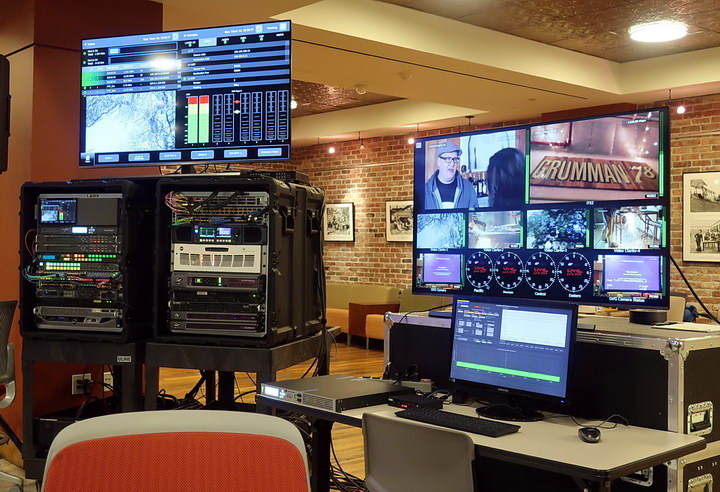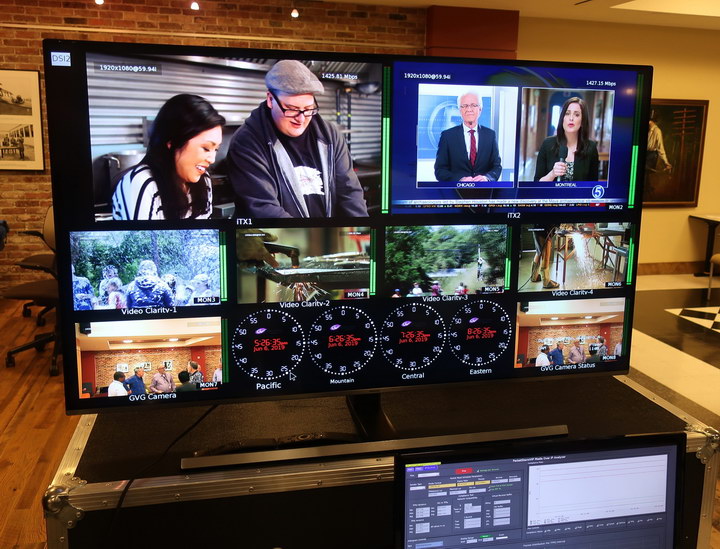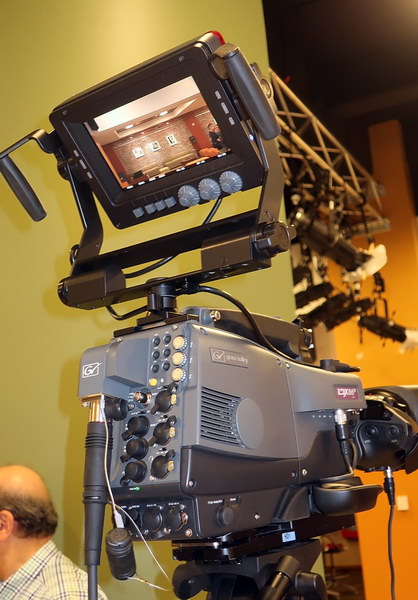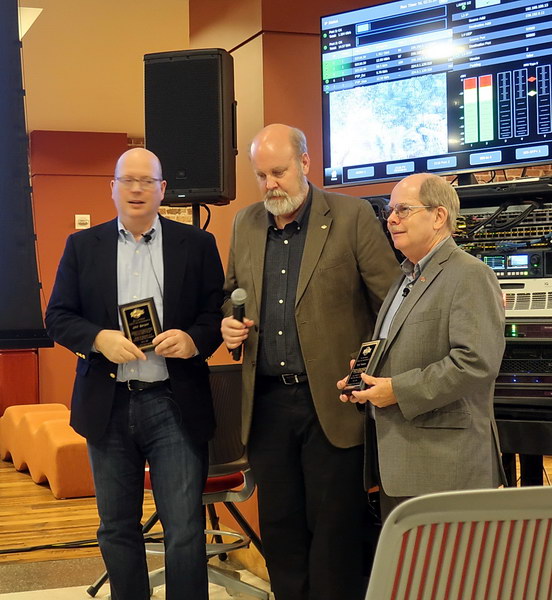The SMPTE suite of standards defining Media over IP, ST-2110-x, is largely approved and in place. This suite of standards, in theory, allows system components from multiple vendors to work together to deliver professional video production and distribution using Internet protocol (IP) connections. In the past, this professional video production has been done by components and connections that were customized for video, audio and ancillary data such as closed captions.

Since the media production industry is tiny compared to the Internet industry, these components and connections were made in relatively small quantity, making them much more expensive than systems with equivalent computing capacity and data transmission capacity that were designed for the Internet but not for real-time media production.
 A small but complete multi-vendor media production system based entirely on the SMPTE ST-2110 family of standards (Credit: M. Brennesholtz)
A small but complete multi-vendor media production system based entirely on the SMPTE ST-2110 family of standards (Credit: M. Brennesholtz)
The suite of standards is in place and the various vendors advertise “SMPTE ST-2110” compliance, so, in theory, everything should work. But does it? If a system is assembled from ST-2110-compliant hardware from an assortment of vendors plus commercial-off-the-shelf (COTS) Internet hardware (e.g. routers and Ethernet cables), can it actually be used in critical media production applications? The media producers for the Superbowl, for example, do not want to risk a glitch in production because hidden incompatibilities between different brands of equipment. While SDI (Serial Data Interface) video hardware may be more expensive than Ethernet and other IP hardware, it has a well-proven track record in the video production world.
Diversified, a full-service systems and media technology integration company, has built an “IP Roadshow” system to demonstrate the interoperability of SMPTE ST-2110 media production components from an assortment of hardware and software vendors in a small but complete production system. I had a chance to see version 3 of this system as part of the SMPTE New York chapter meeting on June 6th. (Version 1 made the rounds starting in the fall of 2017.) Karl Paulsen, Chief Technology Officer of Diversified and a SMPTE fellow, gave a presentation on the system and then stayed to demonstrate it and answer questions. Paulson told me that all the internal interconnections in the system were via IP, not SDI, although the system had SDI input and output capabilities plus HDMI output for monitors. Components used in the system included:
- Tektronix
- PRISM Media Monitoring and Analysis Platform
- SPG (IP Precision Time Protocol (PTP) Source) (Two units)
- Video Clarity IP VenuePlayer
- Imagine
- Control Panel
- Magellan SDN Orchestrator (Software Control System for Hybrid Baseband/IP Facilities)
- Selenio Network Processor
- Grass Valley (GV)
- Control Panel
- IQUCP 25/50, a multichannel video-over-IP transceiver (Designed by SAM (Snell Advanced Media), recently acquired by GV)
- Convergent Router Control & Configuration System
- iTX (2-CHAN Player)
- KIP X320 MultiViewer
- SAM IQRCIF enclosure with power supplies and gateways
- XCU Universal UXF Camera control unit (CCU)
- LDX86N 4K HDR camera with a Canon HD Lens
- Arista 7280 (Leaf) and 7060 (Spine1)
- Cisco 92160 (Leaf) (multiple units) and 9236 (Spine2)
- Embrionix SDI to IP and IP to SDI converters
- PacketStorm
- VIP Media over IP Analyzer
- Capture/Replay System (CRS)
- VMware Hypervisor virtual machine monitor (Software)
- TSL PAM-IP Audio Monitor
- Samsung UN55NU8000 4K HDR TVs
 One Samsung UN55NU8000 being used as a system monitor using a multiviewer system. Note the output from the Grass Valley Camera showing the SMPTE meeting in the lower left and right corners. The six other video signals visible were pre-recorded onto internal memory. (Credit: M. Brennesholtz)
One Samsung UN55NU8000 being used as a system monitor using a multiviewer system. Note the output from the Grass Valley Camera showing the SMPTE meeting in the lower left and right corners. The six other video signals visible were pre-recorded onto internal memory. (Credit: M. Brennesholtz)
The Samsung UN55NU8000 4K HDR TVs were used as the main monitors in the system, as can be seen in the images. These are fairly high-end 55” LCD-based consumer TVs with a consumer MSRP of $999. They were linked to the main IP Roadshow system via HDMI since they are not capable of Media over IP input. They are a good example of the use of COTS equipment in a production environment.
 Grass Valley HDR GV LDX86N camera with a GV EyeCatcher EC 744/15 OLED monitor used as a viewfinder. (Credit: M. Brennesholtz)
Grass Valley HDR GV LDX86N camera with a GV EyeCatcher EC 744/15 OLED monitor used as a viewfinder. (Credit: M. Brennesholtz)
The meeting was streamed live and recorded for future streaming from the SMPTE YouTube channel. As you might expect, the IP Roadshow system was used to produce the meeting. The video was acquired by the 4K HDR GV LDX86N camera with a Canon lens. The camera used a GV EyeCatcher EC 744/15 OLED monitor as a viewfinder. This monitor has a 188 mm (7.4 in.) diagonal and 960 x 540 resolution. With a peak brightness of 350 cd/m², it would not be suitable for use in outdoor camera shoots. The IP capabilities of this camera were used to connect it to the IP Roadshow system. The projectors used in the talk were permanently installed in the venue, supplied by AT&T, and were not connected by IP.
 Reaction of the system to a typical operator action (Credit: Karl Paulsen)
Reaction of the system to a typical operator action (Credit: Karl Paulsen)
In his talk, Karl Paulsen discussed how IP addresses were associated with specific, human understandable names during the system setup. The operator controlling the system did not need to know that Camera 7 had an IP address of 238.6.74.22, he just needed to know it was Camera 7. The image above shows the flowchart of what happens to various IP addresses when the system operator wants to switch Camera 7 to show on Monitor 3, from when the operator presses the conventional control button to when he gets confirmation on the control panel that Monitor 3 is now showing Camera 7.
Paulsen emphasized that SMPTE wasn’t the only organization involved in Media over IP. The IEEE 1588 Precision Time Protocol (PTP) is particularly important because it synchronizes all the video signals over an IP system that was originally designed to be asynchronous. Other major inputs to the SMPTE ST-2110 family of standards came from the Audio Engineering Society (AES), the Video Services Foundation (VSF) and the Advanced Media Workflow Association (AMWA)
 Speakers at the SMPTE June 6th event. Left to right: John Bertoni of Dell EMC, Wes Simpson representing SMPTE and Karl Paulsen of Diversified. (Credit: M. Brennesholtz)
Speakers at the SMPTE June 6th event. Left to right: John Bertoni of Dell EMC, Wes Simpson representing SMPTE and Karl Paulsen of Diversified. (Credit: M. Brennesholtz)
There was also a second speaker at the SMPTE meeting, John Bertoni of Dell EMC. He discussed the use of cloud computing for video production, as opposed to using in-house capabilities. Companies are switching to the cloud for a variety of reasons, the two most important of which are to free up IT time and cost reduction. He emphasized there isn’t just one “Cloud,” there are multiple clouds such as the Amazon Cloud, the Microsoft Cloud, etc. He said migrating from in-house resources to the cloud is relatively easy and straightforward but be careful. Once you have chosen a cloud, it is very much more difficult to migrate from one cloud to another than it was to migrate from in-house to the cloud in the first place. He also said that you almost certainly are going to deal with more than one cloud whether you want to or not. According to him, 93% of cloud users wind up deploying workloads across two or more clouds. Nothing is simple in this life. –Matthew Brennesholtz

